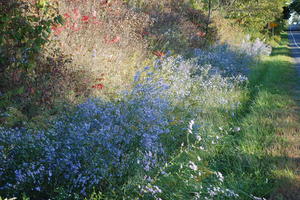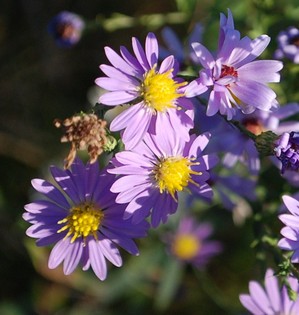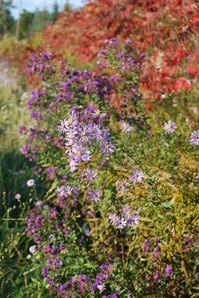
Smooth aster (Symphyotrichum laeve) beautifies Wagner Road in the late afternoon.
Rick Meader | Contributor
So you’re driving along the same country road you were driving along last week when you saw a plant covered with deep purple flowers, but this time the plant’s flowers aren’t exactly deep purple. They’re lighter, more lavender, but equally as colorful and pleasing to the eye.Â
No, your color vision isn’t fading; you’re seeing Smooth Aster (Symphyotrichum laeve - formerly, and affectionately, known as Aster laevis), another widely spread native plant. This perennial with a long life gets around, but especially likes dry fields and open woods, which makes it quite prevalent along our roadsides.

A close-up view of smooth aster.
Rick Meader | Contributor
Smooth aster gets its common name from its leaves, which are almost leathery to the touch (but smooth leather, like a calf). Like the New England Aster we talked about last week, Smooth aster’s leaves are shaped like elongated triangles that clasp the stem, but the leaf similarities end there. These leaves are very smooth, and not hairy. The stem may be reddish in color. Smooth aster’s flowers are shaped much like the New England aster’s flowers and are about the same size (about an inch in diameter), but the purple ray flowers around the yellow disk flowers at the center are much lighter in color. It starts to bloom in August, and continues through October, so we’ve still got some good weeks of color ahead of us.
Like the other asters, Smooth aster is a great source of nectar for bees and butterflies and if you have them in your yard, a sunny day is a buzz of activity. One of my favorite things to do now is go out in my yard in the later afternoon of a sunny day, where my asters and goldenrods are blooming, and face the west, so backlighting is in full effect.Â
A convention of bees, flies, and an occasional moth is buzzing around, gathering nectar from the multitude of flowers on the plants. The backlighting especially helps see the little guys. I don’t know my insects very well, but it’s very rewarding to me to see the popularity of my garden amongst the critters that don’t have much of a voice.Â
It’s also a good chance to show my daughters that bees really don’t want to sting them. They’re just after food, and if we leave them alone, they’ll leave us alone because they’ve got better goals than just stinging us, like dinner.
Also like New England Aster, it is native to almost the entire eastern half of the United States and Canada, with only Florida being left out of the party. The USDA plant website shows its native range. I’m not sure if this is a positive or negative for the plant, but a Kansas Wildflowers website reports Native Americans used the smoke of burning Smooth aster to revive an unconscious person. I’m sure there were many other ethnobotanical uses for it, but my usual sources didn’t list any.

New England aster (Symphyotrichum novae-angliae) and Staghorn sumac (Rhus typhina) back up smooth aster for a symphony of colors.
Rick Meader | Contributor
This plant also reaches about the same size as New England aster (about 3-5 feet). If you’re interested in using it in a landscape design that wouldn’t benefit from some late-season flow, or gangliness, I’d recommend hacking it back to one-half or one-third its height in June to provide the excellent blooms that make this an outstanding plant for your garden in a bushier form that will be about 3 feet or so in height.
There are some other light-blue to lavender-colored asters that bloom in this area, including Sky blue aster (Symphyotrichum oolentangiense), Heart-leaved aster (Symphyotrichum cordifolium) and Short’s aster (Symphyotrichum shortii), all of which have their favorite habitats, so investigate them further if you’d like, and consider putting them all in your yard if you have some areas with good sun and partial shade, and you’ll add a lot of fall color for you and your insect friends to enjoy.
This week, blooming in my yard are Smooth aster, heart-leaved aster, calico aster, arrowhead aster, New England aster, bluestem goldenrod, Canada goldenrod, brown-eyed susan and white snakeroot. Showing up with some striking seeds are carrion flower, jack-in-the-pulpit, Solomon’s seal, False Solomon’s seal and Wild Coffee/Horse Gentian.
Get out and enjoy nature, everyone!
Rick is a local landscape architect with a special interest in all things natural, including native plants and the critters that eat them. You can contact him at yourland1824@gmail.com.





Comments
Cedric Richner
Wed, Oct 13, 2010 : 10:02 a.m.
Rick: I love your articles. Thanks for providing them. I always learn something useful- such as your tip about cutting the Aster back in June...